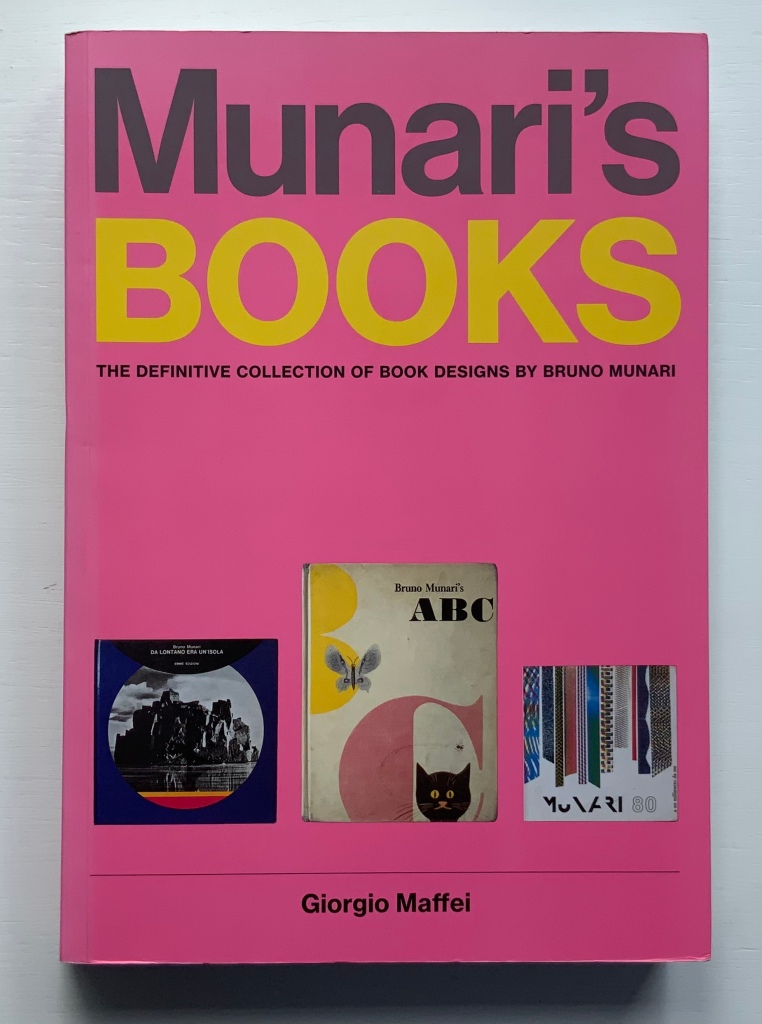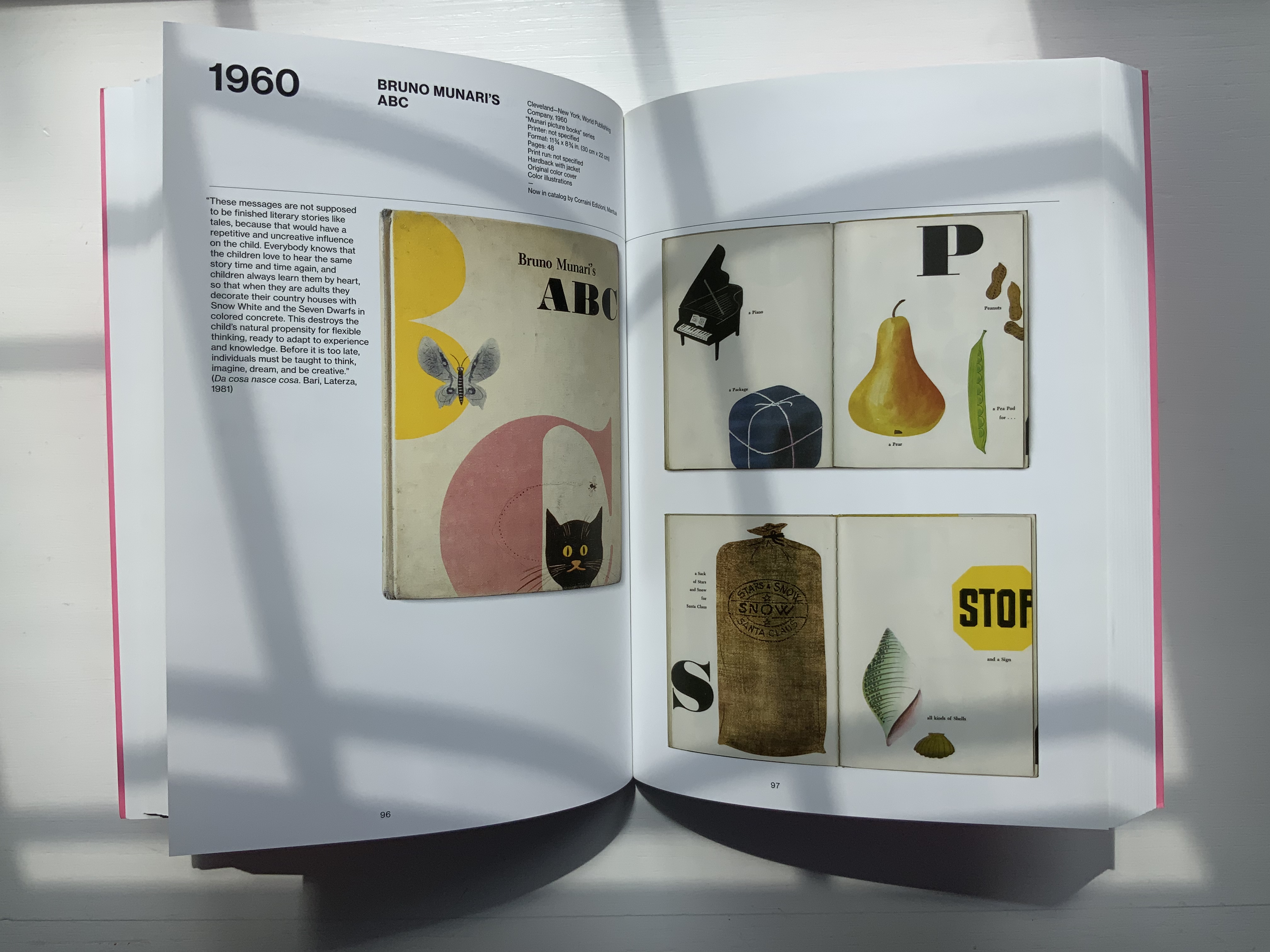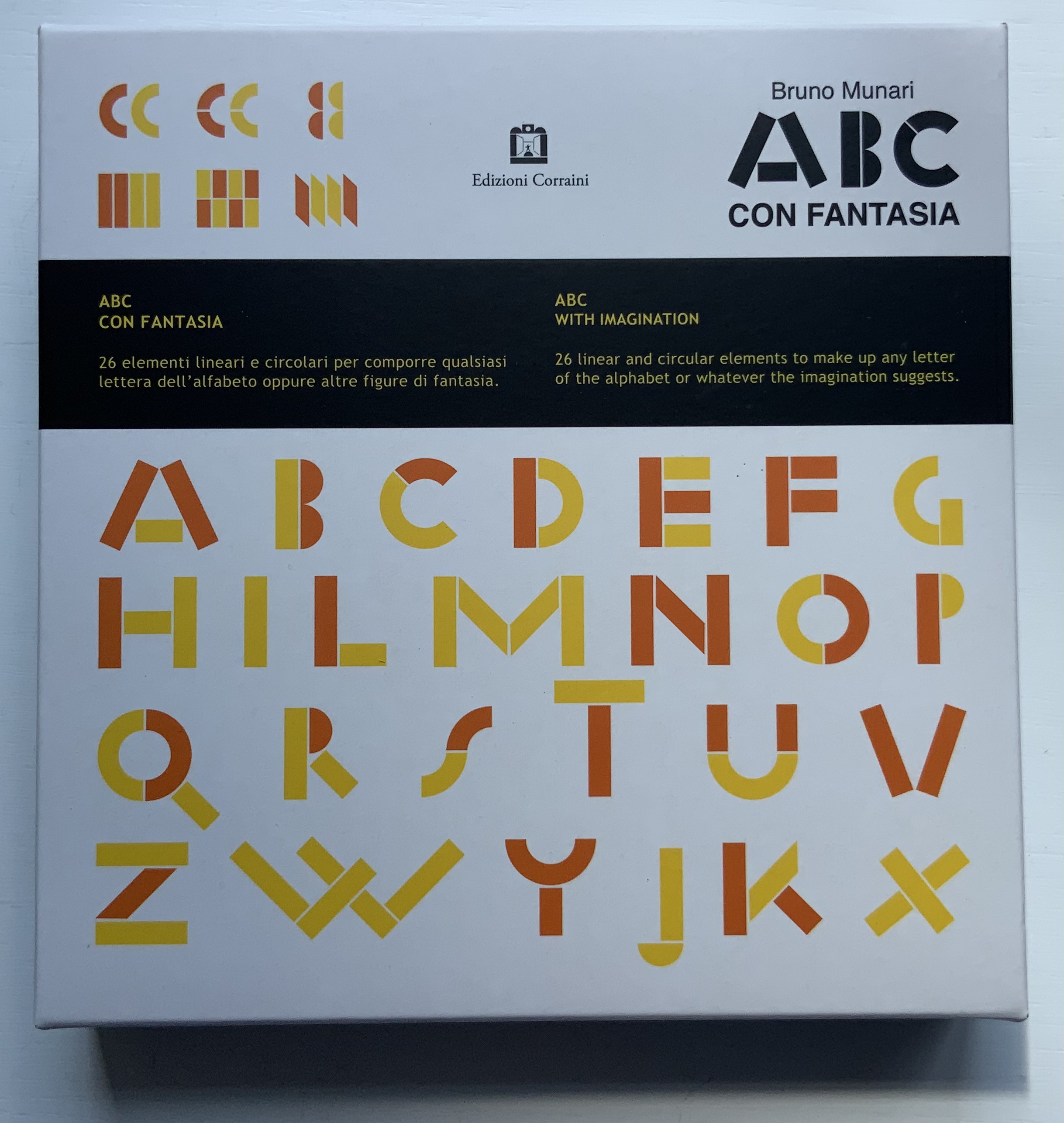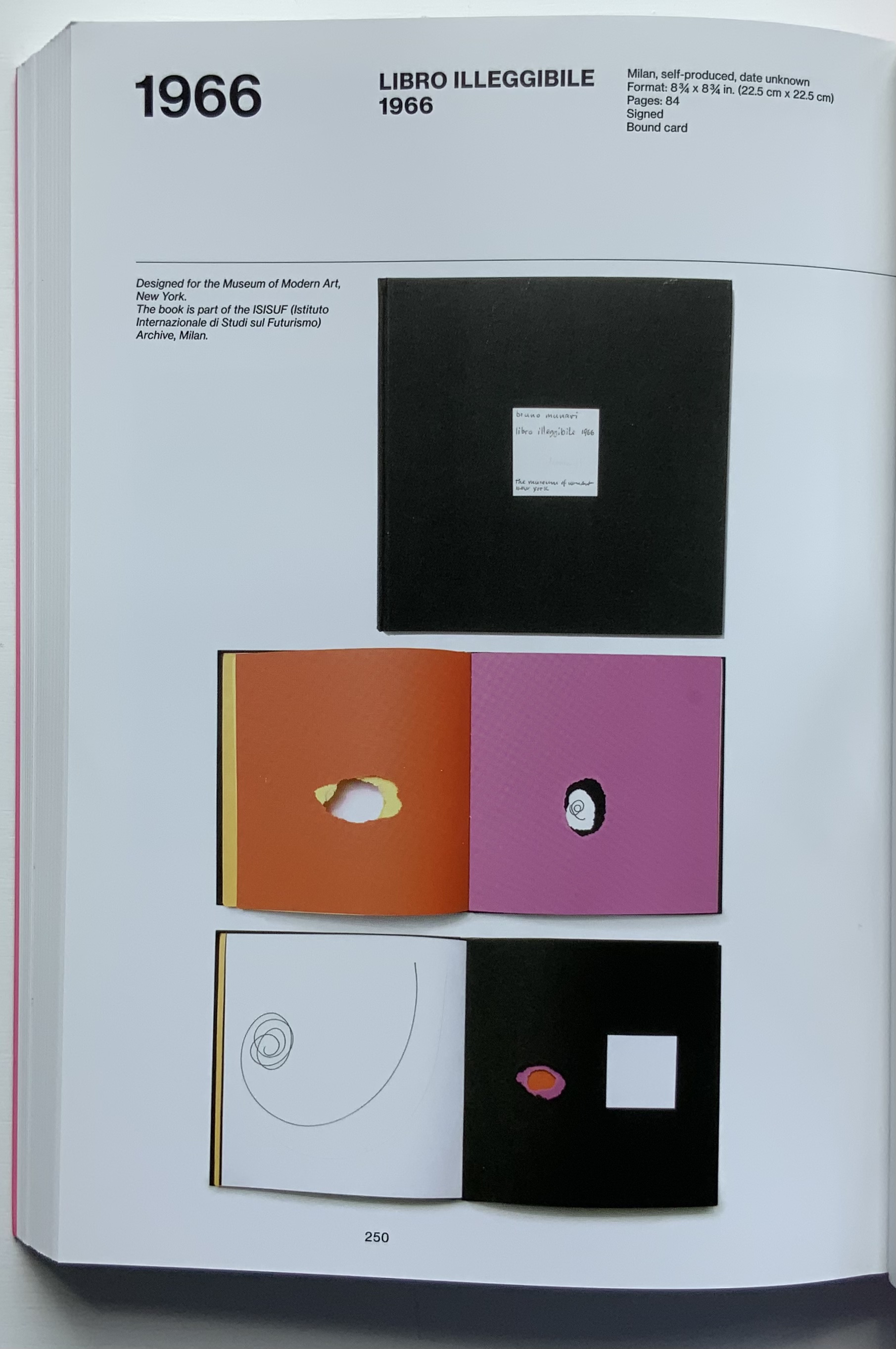Munari’s Books (2008/2015)

Munari’s Books (2008/2015)
Giorgio Maffei
Perfect bound book. H240 x W170, 286 pages. Acquired from Wordery, 25 June 2015.
Photos of the work: Books On Books Collection. Displayed with permission of Corraini Edizioni. © Bruno Munari. All rights reserved to Maurizio Corraini s.r.l.
Giorgio Maffei’s 2008 definitive collection of book designs by Bruno Munari brings together two of Italy’s renowned book artists. Giorgio Maffei’s own work, his writing and gallery/bookshop (highlighted by his son Giulio Maffei’s extraordinary video catalogues Le vite dei libri) warrant a catalogue raisonné in their own right. The Italian edition published by Munari’s long-time publisher Maurizio Corraini was followed up in 2015 by this translation by Martin John Anderson and Thomas Marshall in 2015. For the Books On Books Collection, one of the great pleasures of Munari’s works is its attention to the alphabet, which this book documents.



Although not shown in Munari’s Books, an alphabet-related work that underscores Picasso’s calling Munari “our Leonardo” is ABC con fantasia (1973/2000). If we are to believe Fra Luca Pacioli, it was Leonardo da Vinci who inspired his “straight lines and curves” exposition for creating letters. Following in their footsteps, Munari provides the linear and curvilinear basics for the collector and offspring to join the game.
ABC con fantasia (2008)



ABC con fantasia (2008)
Bruno Munari
Boxed set of shapes. H x W Acquired from Corraini Edizioni, 4 August 2020.
Photos of the work: Books On Books Collection. Displayed with permission of Corraini Edizioni. © Bruno Munari. All rights reserved to Maurizio Corraini s.r.l.





Another pleasure is how Munari’s works lead to other works in the collection. Just by preceding them in Pieter Brattinga’s Kwadraatblad/Quadrat-prints series, Munari’s An Unreadable Quadrat-Print (1953), below, conjures up Wim Crouwel‘s, Gerard Unger‘s, Timothy Epps and Christopher Evans‘, and Anthon Beeke‘s more alphabetical contributions.
Libro illeggibile bianco e rosso / An unreadable Quadrat-Print / Een onleesbaar kwadraat blad / Ein unlesbares Quadrat-Blatt (1953)



Libro illeggibile bianco e rosso/An unreadable Quadrat-Print/Een onleesbaar kwadraat blad/Ein unlesbares Quadrat-Blatt (1953)
Bruno Munari
Artist book. 250 x 250 mm + 1 wrapper (770 x 770 mm folded to 260 x 260 mm). Acquired from Antiquariaat A. Kok & ZN, 4 August 2021.
Photos of the work: Books On Books Collection. Displayed with permission of Corraini Edizioni. © Bruno Munari. All rights reserved to Maurizio Corraini s.r.l.

Although there are no words on numbered pages that have to fall in the right order, An Unreadable Quadrat-Print still presents the author/printer/binder with a challenge in imposition. White and red alternate, which is easy enough, but to cut or not cut a folio on the left and right, how to cut it, how to place the differently cut folios in the right order to achieve the variation in images when the pages turn, how to ensure a sewable area down the center for each folio whether it has a horizontal cut extending into the spine or a diagonal one extending from some point along the spine — that is impressive. It speaks to the sculptural process and result in making books, as well as the sculptural process of reading them.
The following sequences — the book’s first five double-page spreads and then its last six — take a normal page-turning approach, always turning from the upper right corner of whatever shape/page is available. Note how, in the last six double-page spreads, the pages and shapes become more complex.











Libro illeggibile (1966), below left, calls to mind Katsumi Komagata’s A Cloud (2007), and the one in the middle foreshadows Eleonora Cumer’s subtle artistry with transparent paper in Circoscrivere lo spazio No. 3 (2021). While Munari’s rare works press modest budgets, some of it — in its simplicity and popular appeal — has led Corraini Edizioni to put it within easier reach. Numerous reissues of the 1984 Libro illeggibile MN 1 have pushed its price to €5. Short of the artist’s signature (which would likely obstruct the aesthetic intention), a copy from the latest 5000-copy print run will “perform” and deliver the same experiential value as one from the earliest run.



From Munari’s Books.
Libro illeggibile MN 1 (2006)

Libro illeggibile MN 1 (2006)
Bruno Munari
Booklet. H100 x W100 mm, 28 pages from 14 sheets cut in various shapes, notched at the center, bound with single loop of red thread over the notch and knotted at the foot of the spine. Acquired from Corraini Edizioni, 4 August 2020.
Photos of the work: Books On Books Collection. Displayed with permission of Corraini Edizioni. © Bruno Munari. All rights reserved to Maurizio Corraini s.r.l.
Munari’s many series of illegible books tap into book artists’ longstanding and ongoing preoccupation with whether a book without words can communicate information, narrative, sensations or feelings through material, shape or color and their permutations. The colors, shape, feel and binding of Libro illeggibile MN 1 evoke simple and sophisticated pleasure in their juxtaposition and sequence. The unchanging straightness of the top edge and the anchoring red thread of the binding set off the changeability of shapes and colors.






The Square (1960), The Circle (1964) and The Triangle (1976)
Corraini Editions has also made Munari’s compendia The Square: Discovery of the Square (1960), The Circle: Discovery of the Circle (1964) and The Triangle: Discovery of the Triangle (1976) available in continuous reprints. The fourth printing from 2015 is shown below.







Le sculture da viaggio di Munari (2019)
Although not a book of Munari’s making, David A. Carter’s Le sculture da viaggio di Munari is one way of bringing the spirit of Munari’s “travel sculptures” into the collection. Carter’s homage carries the blessing of Corraini Edizioni, further justifying its inclusion.

Le sculture da viaggio di Munari (2019)
David A. Carter
Pop-up book. H210 x W210, 10 constructions over 5 spreads, 2 with fold-out leaves. Acquired from Corraini, 4 August 2020.
Photos of the work: Books On Books Collection. Displayed with permission of Corraini Edizioni. © Bruno Munari. All rights reserved to Maurizio Corraini s.r.l.
Travel sculptures started off as small sculptures (some even pocket-sized) to carry with you, so you could take part of your own culture to an anonymous hotel room. Later they were turned into ‘travel sculptures’, five or six metres tall and made of steel. One of these was seen for a few months in Cesenatico, another one in Naples. Others are sleeping among huge trees in the Alto Adige region.’ This is how Italian designer Bruno Munari (1907-1998) described his ‘travel sculptures’, which in turn inspired American illustrator and designer David A. Carter for this pop-up book. –Corraini Edizioni website. Accessed 3 August 2021.


Munari’s travel sculptures also recall works in the collection like Cumer’s scultura da viaggio dipinta n.2 (2017), Komagata’s「Ichigu」(2015) and, albeit less portable, Ioana Stoian’s Nous Sommes (2015).
Further Reading
Beckett Sandra L. 2013. Crossover Picturebooks : A Genre for All Ages. London: Routledge.
Morison, Stanley, and Philip Hofer. 1933. Fra Luca de Pacioli of Borgo San Sepolcro: some consideration of his life and works. New York: Grolier Club.
Tanchis, Aldo. 1987. Bruno Munari : design as art. Cambridge, MA: MIT Press.
“Mina Loy”. 10 August 2019. Garadinervi : repertori. Accessed 8 February 2023.

Mina Loy, Alphabet, No II, n.d. [1941] [Mina Loy papers, Box 7, Folder 184, YCAL MSS 6. Yale University Library, Beinecke Rare Book and Manuscript Library, New Haven, CT]. Also in Margaret Konkol, “Prototyping Mina Loy’s alphabet“, Feminist Modernist Studies, Volume 1, 2018, pp. 294-317 – Issue 3: Special Cluster: Feminist Modernist Digital Humanities.
They are certainly my favorite toys.
LikeLike